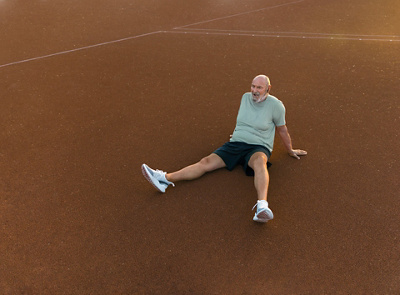Varicose veins which cause symptoms or disturb the patient cosmetically can be surgically removed. Often minimally invasive procedures are used, which can be performed on an outpatient basis. Varicose veins are also sometimes stripped (vein stripping). The procedure which is selected depends on the extension and localisation of the varicose veins.
Varicose veins (named varices or varicosis) are superficial, diseased, extended veins. They often occur on the lower leg. The blood flow in the leg veins is guaranteed in the direction of the heart through the compression of the muscles (muscle pump). Vein valves prevent blood flowing backwards as a result of gravity. Defective vein valves are generally responsible for varicose vein formation. The reason for the defect is generally a genetic weakness in the connective tissue. The backflow of the blood into the leg forms snakelike varicose veins in the larger superficial veins, and into branch- or star-like extensions, known as spider-veins, in the smaller skin veins.
Minimally invasive procedures in the case of varicose veins
The minimally invasive procedures which are performed under local anaesthesia and usually on an outpatient basis include foam sclerotherapy, phlebectomy and endoluminal laser treatment or radiofrequency catheter treatment.
What preparations are carried out before the procedure?
The preparation includes an in-depth examination by a vein specialist (angiologist). With the help of ultrasound examinations (duplex sonography) and radiological imaging of the veins (phlebography), the vein disorder is captured precisely. In this way, suitable treatment methods can be determined. The patient must stop taking blood-thinning medication prior to surgery.
How is the operation performed?
Foam sclerotherapy
The principle of foam sclerotherapy lies in triggering an inflammatory reaction in the affected vein. This should lead to adhesion (sclerosation) and to a slow deterioration in the varicose vein. During foam sclerotherapy, fluid sclerotherapy is administered into the varicose veins over an injection needle, which foams up and at best pushes the blood out of the vein. The foam building leads to longer contact of the sclerosing agent with the vein wall and thus to a stronger inflammatory reaction.
Complications are rare. Sometimes a patient can have an excessive reaction to the sclerotherapy with severe inflammation of venous inflammation (thrombophlebitis). A pressure bandage must be worn after the procedure for some time.
Phlebectomy
During a phlebectomy, also known as the hook technique, the affected veins are hooked and pulled out with a hook through small incisions in the skin. A phlebectomy is used in the case of smaller varicose veins and is often combined with vein stripping.
Complications are rare. Sometimes bruising (haematomas) can occur after the procedure. Compression stockings must be worn after the procedure for some time.
Endoluminal laser treatment, endoluminal radiofrequency-catheter treatment
The principle of endoluminal laser or radiofrequency therapy is to destroy, respectively seal the varicose veins with heat. A laser catheter or radio wave catheter is inserted into the affected vein over the skin incision. Both methods generate heat of approx. 120 degrees Celsius and thus seal the veins. The surrounding tissue must be anaesthetised and cooled due to the heat generation. This is done with tumescence anaesthetic.
Complications are rare. Compression stockings must be worn after the procedure for some time.
What is the success rate of this procedure?
The success rate of minimal invasive varicose vein treatments is good. During sclerotherapy techniques and thermal methods, recurrences can occur as the veins are not removed. New varices can form in other sections after all these treatment methods.
After the minimal invasive procedures, there are practically no residual scars.
Vein stripping
Open surgical treatment, vein stripping, is the traditional treatment for varicose vein treatment. In comparison to the minimally invasive endovenous procedure, it is more stressful for the patient, has a higher risk of complications and leaves larger scars. For this reason, it is now the second method of choice for many surgeons and is only used when a minimally invasive treatment is not possible.
What preparations are carried out before the procedure?
The procedure is usually performed under general anaesthetic or with spinal anaesthesia. As such, prior to an operation the usual assessments are required – such as a blood test, blood pressure measurement and an ECG. The patient must stop taking blood-thinning medication prior to surgery.
How is the operation performed?
The affected vein is bound and separated (crossectomy) via an incision in the groin. This is done near the groin on the juncture of the lower vena saphena magna. Further down on the leg at the other end of the affected vein, this is also freed, disconnected and severed via an incision in the skin. Finally, a special probe, a vein stripper, is pushed through the entire length of the varicose vein. The vein stripper can either be introduced from above or below into the varicose veins. When the probe is pulled out, the vein is removed (stripped).
What is the success rate of this procedure?
The success rate after vein stripping is just as good as in the case of minimal invasive procedures. New varices can form in other places after the other treatment methods.
What are the possible complications and risks of this procedure?
The procedure is low-risk and complications do not usually occur. As with all surgery, the operation may lead to infections, post-operative haemorrhaging or blood clots (thromboses) in rare cases. Haematoma, swelling or tension in the legs sometimes occur. Nerve damage is rare.
What happens after the operation?
Check-ups are required after the operation and the patient must wear compression stockings for at least three months.
Centres 7
-
Center for Erectile Dysfunction
c/o Mittelland Centre for Vascular Medicine
Aarenaustrasse 2B
CH-5000 Aarau -
Vascular Surgery Lucerne LUVAS
Monday to Thursday
08.00 - 12.00 h and 13.00 - 17.00 h
Friday
08.00 - 12.00 h , closed afterwards -
Vein Centre at Klinik St. Anna
St. Anna-Strasse 32 6006 Luzern

